Radinosiphon leptostachya
Radinosiphon leptostachya (Baker) N.E.Br.
Family: Iridaceae
Common names: slender-spiked radinosiphon (Eng.); blou angelier (Afr.)
Introduction
Radinosiphon leptostachya is a cormous deciduous perennial plant with slender stems and pink flowers in summer, that thrives in rocky environments amongst grasses.
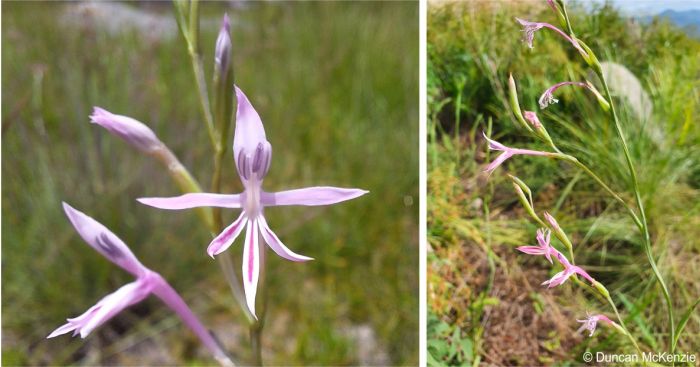
Description
Description
Radinosiphon leptostachya is a slender herbaceous perennial growing to a height of 150-500 mm from a corm that is 10-20 mm diameter. The corms are covered with a pale brown and membranous, slightly fibrous tunic. The aerial part of this plant dies back in winter and resprouts annually. This stem of this plant maybe simple or have up to three branches. The stem has leaves below the inflorescence reducing in size higher up the stem. The leaves are narrowly lanceolate growing 8-15 mm wide, with parallel veins often visible on the blades and slightly raised margins and midrib. The leaves grow basally and are attached to an above ground stem growing to 450 mm long, and sometimes grow longer than the stem. It produces zygomorphic, odourless, pink to purple flowers, with each plant producing a spike of 4 to 12 flowers in opposite arrays. The flowers are laterally symmetric, with 6 unequal, narrow and thin tepals forming a narrowly cylindrical perianth tube that is up to 30 mm long. The uppermost tepal is the widest, and it is located at the flower throat. There are 2 other lance-shaped tepals growing on each side, appearing as the longest. The 3 lower side petals are striped in the middle with a dark pink line and they are the only tepals with a dark line. There are 3 darker anthers that grow below halfway up the length of the upper tepal, behind these anthers is a 3-branched style that is usually taller than the anthers. The fruit of this plant is a 3-lobed, globose to angular capsule that is 4-5 mm long, containing 2 shiny seeds per capsule.

Conservation Status
Status
Radinosiphon leptostachya is not threatened, it is assessed as Least Concern (LC) in the Red List of South African Plants.
Distribution and habitat
Distribution description
Radinosiphon leptostachya is indigenous to South Africa, Eswatini, Mozambique, Zimbawe, Malawi, Tanzania and Zambia. In South Africa it is found in the east of the Mpumalanga Province, where it grows among quartzite rocks in grassland, at the foot of koppies, boulders, cliffs and on mountain slopes, in full sun.
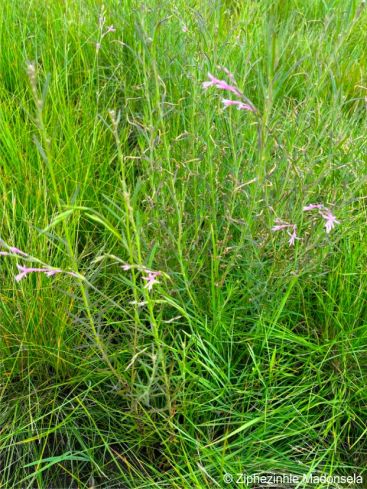
Derivation of name and historical aspects
History
The genus name is a combination of two Greek words radinosus, meaning ‘slender’ and siphon meaning ‘tube’, defining the slender flower tube typical of the Radinosiphon species. The species name leptostachya is also derived from two Greek words, leptos meaning ‘slender’ and stachys meaning ‘an ear of grain or corn’, referring to the shape of the inflorescence. Radinosiphon leptostachya was previously named Lapeirousia leptostachya. Its Afrikaans common name blou angelier translates to ‘blue carnation’ due to the plant’s appearance, even though carnation is a common name normally used for Dianthus species.
Radinosiphon is a genus of flowering plants in the Iridaceae family that was first described as a genus in 1932. It falls under the Crocoideae, one of the major subfamilies of the iris family, containing about 995 species, just more than half of the total species within the Iridaceae. Most of the species in this subfamily are distributed in Africa. The most common species of the Crocoidea are Crocosmia, Gladiolus and Freesia. Typically, the members of this subfamily have sword-shaped leaves, mostly corms as rootstocks, and usually odourless flowers.
Radinosiphon has two species, in South Africa, they have only been spotted in Mpumalanga Province. The other species is Radinosiphon lomatensis and is believed to be endemic to Ehlanzeni district of Mpumalanga Province. Both these species grow from a corm, have sword-shaped basal leaves and 6 petals which are typical features of the Iridaceae family. Radinosiphon lomatensis is easily distinguished from R. leptostachya, by its bigger flowers and longer perianth tube, and its fruit capsules having more than 2 seeds, producing up to 8 seeds per capsule.
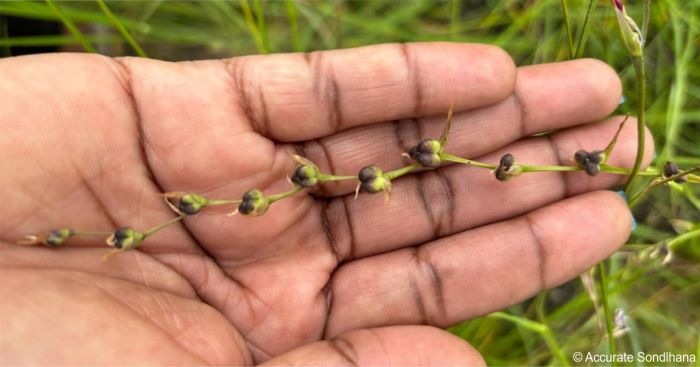
Ecology
Ecology
Radinosiphon leptostachya is adapted to a summer-rainfall climate. It dies back and becomes dormant during the dry and cold winter months. The leaves resprout and grow in spring (September-October), and it flowers in midsummer (December to February).
Nectar is primarily produced at the base of the flower from the glands located in the ovary, which is situated where the flower forms a tube-like structure. The flower is visited by various insects and is pollinated by the long-proboscid fly Prosoeca ganglbaueri.
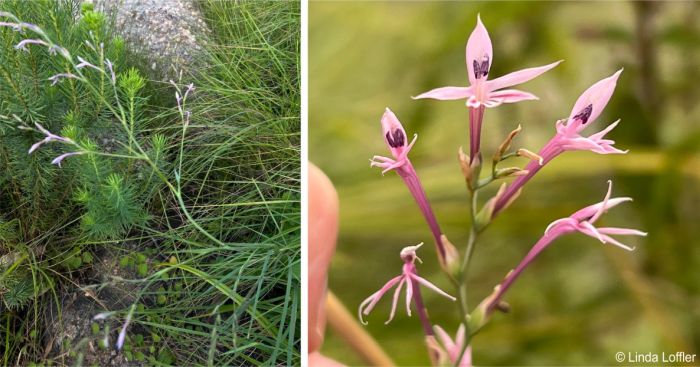
Uses
Use
Radinosiphon leptostachya is a rarely used plant in horticulture. In the garden it is best suited to a rock garden, in full sun, where it must be planted amongst grasses that can support its slender stems.
Radinosiphon leptostachya is one of the corms used in the preparation of a Zambian dish called Chikanda.
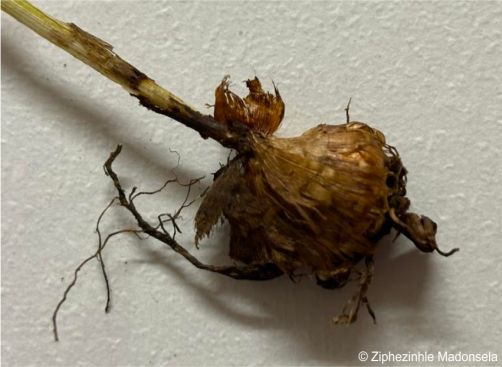
Growing Radinosiphon leptostachya
Grow
Radinosiphon leptostachya is propagated by seeds and division of the corms.
Seeds should be sown in well-drained soil and kept moist until germination. Seeds should be collected and stored in a cool dry place and sown in spring.
Propagation through division of the corms has a high success rate. A corm is an underground stem, usually with roots. During the growth cycle, this plant produces small cormlets from the parent corm, these cormlets are primary reproductive structures of the plants. The cormlets should be collected 4 to 6 weeks after flowering has completed. The cormlets should be cleaned by removing the soil, and 2 cm of a stem should remain for propagation. Plant these cormlets into a well-drained soil.
References
- Attwood, S. 2023. Observation of Radinosiphon leptostachya, City Of Mbombela Rural, Mpumalanga. iNaturalist. Online. https://www.inaturalist.org/observations/191835553.
- Attwood, S. 2023. Observation of Radinosiphon leptostachya, City Of Mbombela Rural, Mpumalanga. iNaturalist. Online https://www.inaturalist.org/Observations/197673312.
- Bingham, M.G., Willemen, A., Wursten, B.T., Ballings, P. & Hyde, M.A. 2024. Radinosiphon leptostachya. Flora of Zambia. Online. https://www.zambiaflora.com/speciesdata/species.php?species_id=116010. Accessed 06/04/2024.
- Biodiversity Explorer. Genus: Radinosiphon. https://www.biodiversityexplorer.info/plants/iridaceae/radinosiphon.htm. Accessed 18/05/2024.
- Goldblatt, P. & Manning, J.C. 2020. Iridaceae of southern Africa. Strelitzia 42. South African National Biodiversity Institute, Pretoria.
- Goldblatt, P. 1996. Iridaceae. Flora of Tropical East Africa. Royal Botanic Gardens, Kew.
- Goldblatt, P., Davies, T.J., Manning, J.C., van der Bank, M. & Savolainen, V. 2006. Phylogeny of Iridaceae subfamily Crocoideae based on a combined multigene plastid DNA analysis. Aliso: A Journal of Systematic and Floristic Botany 22(1):399-411.
- JSTOR Global Plants. compilation. https://plants.jstor.org/compilation/Radinosiphon.leptostachya. Accessed 18/05/2024.
- Latti, I. n.d. Radinosiphon leptostachya. Operation Wildflower.. Online. https://www.operationwildflower.org.za/index.php/albums/bulbs/radinosiphon-leptostachya-nelspruit-judd-4-12296. Accessed 07/04/2024.
- Loffler, L. 2023. Observation of Radinosiphon leptostachya, Hhohho Region, Eswatini. iNaturalist. Online. https://www.inaturalist.org/observations/150555562.
- Loffler, L. 2024. Observation of Radinosiphon leptostachya, Hhohho, Mbabane. iNaturalist. Online. https://www.inaturalist.org/observations/199592966.
- McKenzie, D. 2021. Observation of Radinosiphon leptostachya, Nelspruit, Mpumalanga. iNaturalist. Online. https://www.inaturalist.org/observations/68369108
- McKenzie, D. 2023. Observation of Radinosiphon leptostachya, Ehlanzeni District Municipality, Mpumalanga. iNaturalist. Online. https://www.inaturalist.org/observations/195364127
- Plants of the World Online. Radinosiphon leptostachya (Baker) N.E.Br. https://powo.science.kew.org/taxon/urn:lsid:ipni.org:names:440632-1. Accessed 07/04/2024.
- Raimondo, D., Von Staden, L., Foden, W., Victor, J.E., Helme, N.A., Turner, R.C., Kamundi, D.A. & Manyama, P.A. (eds) 2009. Red list of South African plants. Strelitzia 25. South African National Biodiversity Institute, Pretoria.
- Saunders, R. & Saunders, R. 2021. Saunders’ field guide to gladioli of South Africa. Penguin Random House, South Africa.
- Wentzel, J. n.d. Radinosiphon leptostachya. Wildflower Nursery. Online. https://wildflowernursery.co.za/indigenous-plant-database/radinosiphon-leptostachya/. Accessed 18/05/2024.
- Wikipedia. Radinosiphon. https://en.wikipedia.org/wiki/Radinosiphon. Accessed 18/05/2024.
Credits
Ziphezinhle Madonsela
Lowveld National Botanical Garden
June 2024
Acknowledgements: the author thanks Simon Attwood, Linda Loffler, Duncan McKenzie and Accurate Sondlhana, for providing images for this article.
Plant Attributes:
Plant Type: Bulb, Perennial
SA Distribution: Mpumalanga
Soil type: Loam
Flowering season: Early Summer, Late Summer
PH:
Flower colour: Purple, Pink
Aspect: Full Sun
Gardening skill: Easy
Special Features:
Horticultural zones








Rate this article
Article well written and informative
Rate this plant
Is this an interesting plant?
Login to add your Comment
Back to topNot registered yet? Click here to register.